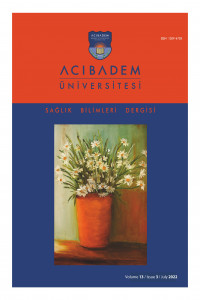Research Article
Clinical Research
Aim & Scope
Acıbadem University Health Sciences Journal is the scientific publication of Acıbadem Mehmet Ali Aydınlar University, which was established in 2008. The aim of the journal is to convey the current developments in health sciences in our country and in the world, especially in the field of medicine, to ensure that original scientific studies are attributed to the scientific world, and at the same time to create a scientific forum where these developments are discussed with their positive and negative aspects. On the other hand, a section under the title of Medicine / Health education is reserved in the magazine in order to train the humanpower that will join the health army of the future with modern methods and to support them to gain the highest level of knowledge and skills.
Articles to be accepted into the journal consist of research, experimental study, case report, review, interesting images and letters to the editor. In addition, news from the medical world, ethics, and articles on medical history are also included. The articles are mainly on medicine and may be from a variety of health-related science fields such as: nursing, physiotherapy, nutrition, health education, health management, sports health, health economics, etc.
The journal is published four times a year in January, April, July and October, only electronically in English.
Submission of articles to the journal, correspondence, sending of the articles to the referees and requesting corrections (if any) from the author, then revising by the editor and notifying the authors that they have been accepted or rejected for publication are done electronically. Another main principle of the journal is that article evaluation is done quickly and the journal is published on time.
Author Guidelines
Editorial procedure
Double-blind peer review
Journal follows a double-blind reviewing procedure. Authors are therefore requested to submit:
A blinded manuscript without any author names and affiliations in the text.
A separate title page, containing title, all author names, affiliations, and the contact information of the corresponding author.
Manuscript Submission
Submission of a manuscript implies: that the work described has not been published before; that it is not under consideration for publication anywhere else; that its publication has been approved by all co-authors, if any, as well as by the responsible authorities – tacitly or explicitly – at the institute where the work has been carried out. The publisher will not be held legally responsible should there be any claims for compensation.
Permissions
Authors wishing to include figures, tables, or text passages that have already been published elsewhere are required to obtain permission from the copyright owner(s) for both the print and online format and to upload evidence that such permission has been granted when submitting their papers as "supporting file”. Any material received without such evidence will be assumed to originate from the authors.
Online Submission
Please follow the hyperlink “Submit article” on the right and upload all of your manuscript files following the instructions given on the screen.
Please ensure you provide all relevant editable source files. Failing to submit these source files might cause unnecessary delays in the review and production process.
ORCID ID
This publication requires that all of the authors provide their ORCID ID before proceeding with submission to prevent author confusions
Reviewer Suggestion
Authors will be kindly asked to suggest 2 potential reviewers for their papers. These recommendations will help to ensure the journal’s high scientific level and support a quick review process, thus reducing the time from manuscript submission to publication. Please note that only reviewer suggestions from internationally respected institutions other than the corresponding author’s institution will be taken into consideration. In addition, the correspondence author should not have previously published any articles together with the suggested reviewers. Reviewers suggested by the authors should have institutional extensions in their e-mail adressess. E-mails with yahoo, gmail, hotmail, etc extensions will not be accepted.
Types of papers
Original Article: Limited to 3000 words, 30 references, no more than 5 figures and 5 tables. In case of multicentric studies, authorship must include no more than 3 authors per each center that contributes to the study.
Review Article: Limited to 4000 words, 60 references, no more than 5 figures and 5 tables. Reviews are published only if they were invited by editor. If you wish to submit a non-invited review please contact with editor-in-chief prior to submission.
Short Communication/Technical reports: Limited to 1200 words, 10 references, no more than 4 figures and tables in total.
Letter to the Editor: Up to 500 words, no more than 5 references
Please note: If the Letter to the Editor comments on a previously published article, the following conditions must be met:
1. The article the Letter to the Editor refers to must have been published in the Acibadem University Health Sciences Journal.
2. The article the Letter to the Editor refers to must be no more than 6 months old (since the date of online first publication).
For all Letters to the Editor, the same rule applies: they must provide something significant and new for the reader.
The final categorization of an accepted submission is dependent on the decision of the Editor in Chief.
Case Reports will not be accepted
Paper preparation
General requirements for paper preparation:
Manuscripts should be submitted in Word format.
Page margins should be 25mm for each, all paragraphs must be justified.
Use a normal, plain font (e.g., 12-point Times Roman), double line-spacing for whole text.
The journal has international reviewers, is covered and is being evaluated by international indices, thus all files (except title and running head in Turkish) submitted to journal and whole communication should be in English.
Headings
Please use no more than three levels of displayed headings.
Abbreviations
Abbreviations should be defined at first mention and used consistently thereafter.
Footnotes
Footnotes can be used to give additional information, which may include the citation of a reference included in the reference list. They should not consist solely of a reference citation, and they should never include the bibliographic details of a reference. They should also not contain any figures or tables.
Footnotes to the text are numbered consecutively; those to tables should be indicated by superscript lower-case letters (or asterisks for significance values and other statistical data). Footnotes to the title or the authors of the article are not given reference symbols.
Always use footnotes instead of endnotes.
Acknowledgments
Acknowledgments of people, grants, funds, etc. should be placed in a separate section on the title page. The names of funding organizations should be written in full.
Scientific style
Please always use internationally accepted signs and symbols for units (SI units).
Which files to upload
Authors must upload following files separately:
- Cover Letter
- Title Page
- Full Text File
- Copyright Form
- Authorship Contributions
- Ethics Committee Approval/Waiver
- Conflict of Interest (Must be saved by right click and filled by Adobe Acrobat Reader
Additionally authors should upload following files separately, if relevant, from Upload Supplementary File button:
- Figures/Pictures
- Tables
- Similarity Report
- Research Data
- Response to reviewers
- Supporting file
Cover Letter
The cover letter is a formal way to communicate with journal editors and editorial staff during the manuscript submission process. Cover letter is a separate document from the manuscript file
The cover letter should be addressed to the journal editor; any interim correspondence is addressed to the editor, section editor or associate editor with whom you have been in communication.
The letter will argue that your manuscript is a good fit for the journal you are submitting it to and highlight your most important findings, write a short paragraph that explains why your manuscript would be a good fit for the journal.
Additionally, the cover letter should include the following information:
• manuscript title
• assurances that all authors agree with the content of the manuscript and with the order of authorship
• notice of any conflicts of interest or activities that might be seen as influencing the research
• verification that the treatment of human participants or nonhuman animal subjects was in accordance with established ethical standard
• The manuscript is original (i.e., you wrote it, not copied it)
• No part of the manuscript has been published before, nor is any part of it under consideration for publication at another journal
• the telephone number, email address, and mailing address of the corresponding author
Title Page
Please provide the following information in the title page.
- A concise and informative full title. (Please avoid use of abbreviations as much as possible)
- A running title (not more than 50 characters including spaces)
- Authors from Turkey must provide also a full title and running title in Turkish matching with English originals.
- Type of the article
- The name(s) of the author(s) (Capitalize initial letter of the Names and all letters of the SURNAME)
- The affiliation(s) of the all author(s), i.e. institution, (department), city, (state), country
- 16-digit ORCID of all the author(s)
- A clear indication and an active e-mail address of all authors
- Additionally, postal address and GSM number of the corresponding author.
Full Text File
Must start with Full Title of the article, which is followed by abstract and Main Text sections.
Main Text must start from the new page after abstract section.
Abstract
Please provide a structured abstract of 150 to 250 words which should be divided into the following sections and followed by keywords:
Purpose (stating the main purposes and research question), Methods, Results, and Conclusion
After the abstract also declare (when applicable) Trial registration number and date of registration (if necessary “retrospectively registered”)
Keywords: Please provide 3 to 6 keywords which can be used for indexing purposes. Keywords must be matching with Medical Subject Headings (MeSH).
Authors from Turkey must provide also an abstract and keywords in Turkish matching with Turkish Science Terms for Turkish.
Main Text
Use the automatic page numbering function to number the pages.
Use italics for emphasis.
Use the continuous line numbering.
Do not use field functions.
Use tab stops or other commands for indents, not the space bar.
Use the table function, not spreadsheets, to make tables.
Use the equation editor or MathType for equations.
Save your file in docx format (Word 2007 or higher) or doc format (older Word versions).
Start your Main Text with full title.
Make your text structured as Introduction, Material and Methods, Results, Discussion, Conclusion, Declarations, Acknowledgement (if necessary), and References.
Declarations
All manuscripts must contain the following sections under the heading 'Declarations'.
If any of the sections are not relevant to your manuscript, please include the heading and write 'Not applicable' for that section
Funding (information that explains whether and by whom the research was supported. If supported also give number)
Conflicts of interest/Competing interests (include appropriate disclosures)
Ethics approval (include appropriate approvals or waivers with date and number. Additionally, upload decision letter wile submitting your article)
Availability of data and material (data transparency)
Authors' contributions (mandatory: This journal accepts authorship criteria defined by ICMJE)
Citation
References should be cited in text in rounded brackets (parentheses) before punctation. If author name is mentioned in the sentence, then cite the reference just after the author name, else, cite at the end of the sentence. If there are more than two authors of the mentioned reference with author name, use et al after the first author, else, write all authors. Consecutive references should be abbreviated with an en-dash. Examples:
Following texts represent examples of citing (1).
Yucel, et al (2) reported that, early and intense nutritional support of cancer patients with risk of malnutrition may lead to less weight loss during radiotherapy.
Kuru Alici and Emiroglu (3) declared the importance of home visit experience in public health nursing.
Several studies investigated effect of cost on choice of treatment modality for certain malignancies (1-3,7).
References
The list of references should only include works that are cited in the text and that have been published or accepted for publication. Personal communications and unpublished works should only be mentioned in the text. Do not use footnotes or endnotes as a substitute for a reference list. Only cite directly utilized sources and please avoid using cited references of utilized sources. Editors or reviewers may request first pages of the references if get suspicious about use of cited reference.
References must be listed according to list of appearance. Use paragraph hanging.
All authors should be quoted for papers with up to three authors; for papers with more than three authors, list the first three followed by 'et al.'.
Use sentence case for titles if no specific name was used.
The first and last page numbers for each reference must be provided as abbreviated.
Always use the standard abbreviation of a journal’s name according to the Index Medicus. If the journal is not abbreviated by Index Medicus please refer to ISSN List of Title Word Abbreviations. If you are unsure, please use the full journal title.
The year followed by ";", volume followed by ":" and the pages; the issue should not be mentioned. If there is DOI It should be mentioned at the end of the line.
Journal article:
1 Kuru Alıcı N and Emi̇roğlu ON. Students’ home visit experiences within the scope of public health nursing course: A qualitative study. Acibadem Univ Saglik Bilim Derg. 2020;12:146-51. DOI:10.31067/acusaglik.834065
2 Yücel S, Kaplan SO, Güral Z, et al. The effect of individual nutritional support and nurse follow-up on weight loss during radiotherapy in cancer patients. 2020;12:63-6. DOI:10.31067/acusaglik.833729
3 Yüksel ME, Tamer F and Avcı E. Does vitamin d deficiency cause direct inguinal hernia? Preliminary results. Acibadem Univ Saglik Bilim Derg. 2020;12:7-11. DOI:10.31067/acusaglik.833318
Congress Proceedings:
4. Braunwald E, Mock MB, Watson JT, et al. Congestive heart failure : Current research and clinical applications. 1982; New York: Grune & Stratton.
Book:
5. Beauchamp RD, Evers BM, Mattox KL, et al. Sabiston textbook of surgery: The biological basis of modern surgical practice. Philadelphia, PA: Elsevier; 2017.
Book Section:
6. Treglia G and Muoio B. Evidence-based pet for brain tumours. In: Treglia G. and Giovanella L., eds. Evidence-based positron emission tomography: Summary of recent meta-analyses on pet. Cham: Springer International Publishing; 2020. p. 25-33. DOI:10.1007/978-3-030-47701-1_3
You can use EndNote reference file by downloading from official website ( https://endnote.com/style_download/acibadem-universitesi-saglik-bilimleri-dergisi/ )
Tables
All tables are to be numbered using Arabic numerals.
Tables should always be cited in text in consecutive numerical order.
For each table, please supply a table caption (title) explaining the components of the table.
Identify any previously published material by giving the original source in the form of a reference at the end of the table caption.
Footnotes to tables should be indicated by superscript lower-case letters (or asterisks for significance values and other statistical data) and included beneath the table body.
All tables should be uploaded in separate files.
Artwork and Illustrations
Electronic Figure Submission
Supply all figures electronically.
Indicate what graphics program was used to create the artwork.
For vector graphics, the preferred format is EPS; for halftones, please use TIFF format.
Vector graphics containing fonts must have the fonts embedded in the files.
Name your figure files with "Fig" and the figure number, e.g., Fig1.eps.
Line Art
Definition: Black and white graphic with no shading.
Do not use faint lines and/or lettering and check that all lines and lettering within the figures are legible at final size.
All lines should be at least 0.1 mm (0.3 pt) wide.
Scanned line drawings and line drawings in bitmap format should have a minimum resolution of 1200 dpi.
Vector graphics containing fonts must have the fonts embedded in the files.
Halftone Art
Definition: Photographs, drawings, or paintings with fine shading, etc.
If any magnification is used in the photographs, indicate this by using scale bars within the figures themselves.
Halftones should have a minimum resolution of 300 dpi.
Color Art
Color art is free of charge for online publication.
Color illustrations should be submitted as RGB (8 bits per channel).
Color artwork should have a minimum resolution of 300 dpi.
Figure Lettering
To add lettering, it is best to use Helvetica or Arial (sans serif fonts).
Keep lettering consistently sized throughout your final-sized artwork, usually about 2–3 mm (8–12 pt).
Variance of type size within an illustration should be minimal, e.g., do not use 8-pt type on an axis and 20-pt type for the axis label.
Avoid effects such as shading, outline letters, etc.
Do not include titles or captions within your illustrations.
Figure Numbering
All figures are to be numbered using Arabic numerals.
Figures should always be cited in text in consecutive numerical order.
Figure parts should be denoted by lowercase letters (a, b, c, etc.).
If an appendix appears in your article and it contains one or more figures, continue the consecutive numbering of the main text. Do not number the appendix figures,"A1, A2, A3, etc." Figures in online appendices [Supplementary Information (SI)] should, however, be numbered separately.
Figure Captions
Each figure should have a concise caption describing accurately what the figure depicts. Include the captions at the end of the text file of the manuscript, not in the figure file.
Figure captions begin with the term Fig. in bold type, followed by the figure number, also in bold type.
No punctuation is to be included after the number, nor is any punctuation to be placed at the end of the caption.
Identify all elements found in the figure in the figure caption; and use boxes, circles, etc., as coordinate points in graphs.
Identify previously published material by giving the original source in the form of a reference citation at the end of the figure caption.
Figure Placement and Size
Figures should be submitted separately from the text.
When preparing your figures, size figures to fit in the column width. The figures should be 84 mm or 174 mm wide and not higher than 234 mm.
Permissions
If you include figures that have already been published elsewhere, you must obtain permission from the copyright owner(s) for both the print and online format and must upload as “Supporting file” while submitting to journal. Please be aware that some publishers do not grant electronic rights for free and that Acibadem Universitesi Saglik Bilimleri Dergisi will not be able to refund any costs that may have occurred to receive these permissions. In such cases, material from other sources should be used.
Accessibility
In order to give people of all abilities and disabilities access to the content of your figures, please make sure that
All figures have descriptive captions (blind users could then use a text-to-speech software or a text-to-Braille hardware)
Patterns are used instead of or in addition to colors for conveying information (colorblind users would then be able to distinguish the visual elements)
Any figure lettering has a contrast ratio of at least 4.5:1
Submission of Revisions
Authors wishing to submit revision after peer-review must submit following files separately:
- Response to Reviewers document, which contains point-to-point explanations.
- Revised manuscript files.
Revised manuscript files must be prepared with Track Changes feature of Microsoft® Office Word. Comments and Tracking must be blinded. Guide for Track Changes feature can be found in official website of Microsoft® https://support.microsoft.com/en-us/office/track-changes-in-word-197ba630-0f5f-4a8e-9a77-3712475e806a
Proofreading
For proofreading please use Adobe Acrobat Commenting tools. Guide for commenting tools can be found in the official website of Adobe Acrobat. https://helpx.adobe.com/acrobat/using/commenting-pdfs.html
Ethical Principles and Publication Policy
Ethical Responsibilities of Authors
This journal is committed to upholding the integrity of the scientific record and will follow the Committee on Publication Ethics (COPE) guidelines on how to deal with potential acts of misconduct.
Authors should refrain from misrepresenting research results which could damage the trust in the journal, the professionalism of scientific authorship, and ultimately the entire scientific endeavour. Maintaining integrity of the research and its presentation is helped by following the rules of good scientific practice, which include*:
- The manuscript should not be submitted to more than one journal for simultaneous consideration.
- The submitted work should be original and should not have been published elsewhere in any form or language (partially or in full), unless the new work concerns an expansion of previous work. (Please provide transparency on the re-use of material to avoid the concerns about text-recycling (‘self-plagiarism’).
- A single study should not be split up into several parts to increase the quantity of submissions and submitted to various journals or to one journal over time (i.e. ‘salami-slicing/publishing’).
- Concurrent or secondary publication is sometimes justifiable, provided certain conditions are met. Examples include: translations or a manuscript that is intended for a different group of readers.
- Results should be presented clearly, honestly, and without fabrication, falsification or inappropriate data manipulation (including image based manipulation). Authors should adhere to discipline-specific rules for acquiring, selecting and processing data.
- No data, text, or theories by others are presented as if they were the author’s own (‘plagiarism’). Proper acknowledgements to other works must be given (this includes material that is closely copied (near verbatim), summarized and/or paraphrased), quotation marks (to indicate words taken from another source) are used for verbatim copying of material, and permissions secured for material that is copyrighted.
- For submitted articles, iThenticate score will be expected to be not more than 15%. (Higgins, J.R., Lin, FC. & Evans, J.P. Plagiarism in submitted manuscripts: incidence, characteristics and optimization of screening—case study in a major specialty medical journal. Res Integr Peer Rev 1, 13 (2016). https://doi.org/10.1186/s41073-016-0021-8)
Important note: the journal may use software to screen for plagiarism.
- Authors should make sure they have permissions for the use of software, questionnaires/(web) surveys and scales in their studies (if appropriate).
- Research articles and non-research articles (e.g. Opinion, Review, and Commentary articles) must cite appropriate and relevant literature in support of the claims made. Excessive and inappropriate self-citation or coordinated efforts among several authors to collectively self-cite is strongly discouraged.
- Authors should avoid untrue statements about an entity (who can be an individual person or a company) or descriptions of their behavior or actions that could potentially be seen as personal attacks or allegations about that person.
- Research that may be misapplied to pose a threat to public health or national security should be clearly identified in the manuscript (e.g. dual use of research). Examples include creation of harmful consequences of biological agents or toxins, disruption of immunity of vaccines, unusual hazards in the use of chemicals, weaponization of research/technology (amongst others).
- Authors are strongly advised to ensure the author group, the Corresponding Author, and the order of authors are all correct at submission. Adding and/or deleting authors during the revision stages is generally not permitted, but in some cases may be warranted. Reasons for changes in authorship should be explained in detail. Please note that changes to authorship cannot be made after acceptance of a manuscript.
*All of the above are guidelines and authors need to make sure to respect third parties rights such as copyright and/or moral rights.
Upon request authors should be prepared to send relevant documentation or data in order to verify the validity of the results presented. This could be in the form of raw data, samples, records, etc. Sensitive information in the form of confidential or proprietary data is excluded.
If there is suspicion of misbehavior or alleged fraud the Journal and/or Publisher will carry out an investigation following COPE guidelines. If, after investigation, there are valid concerns, the author(s) concerned will be contacted under their given e-mail address and given an opportunity to address the issue. Depending on the situation, this may result in the Journal’s and/or Publisher’s implementation of the following measures, including, but not limited to:
- If the manuscript is still under consideration, it may be rejected and returned to the author.
- If the article has already been published online, depending on the nature and severity of the infraction:
- an erratum/correction may be placed with the article
- an expression of concern may be placed with the article
- or in severe cases retraction of the article may occur.
The reason will be given in the published erratum/correction, expression of concern or retraction note. Please note that retraction means that the article is maintained on the platform, watermarked “retracted” and the explanation for the retraction is provided in a note linked to the watermarked article.
- The author’s institution may be informed
- A notice of suspected transgression of ethical standards in the peer review system may be included as part of the author’s and article’s bibliographic record.
Fundamental errors
Authors have an obligation to correct mistakes once they discover a significant error or inaccuracy in their published article. The author(s) is/are requested to contact the journal and explain in what sense the error is impacting the article. A decision on how to correct the literature will depend on the nature of the error. This may be a correction or retraction. The retraction note should provide transparency which parts of the article are impacted by the error.
Suggesting / excluding reviewers
Authors are welcome to suggest suitable reviewers and/or request the exclusion of certain individuals when they submit their manuscripts. When suggesting reviewers, authors should make sure they are totally independent and not connected to the work in any way. It is strongly recommended to suggest a mix of reviewers from different countries and different institutions. When suggesting reviewers, the Corresponding Author must provide an institutional email address for each suggested reviewer, or, if this is not possible to include other means of verifying the identity such as a link to a personal homepage, a link to the publication record or a researcher or author ID in the submission letter. Please note that the Journal may not use the suggestions, but suggestions are appreciated and may help facilitate the peer review process.
Authorship principles
These guidelines describe authorship principles and good authorship practices to which prospective authors should adhere to.
Authorship clarified
The Journal and Publisher assume all authors agreed with the content and that all gave explicit consent to submit and that they obtained consent from the responsible authorities at the institute/organization where the work has been carried out, before the work is submitted.
The Publisher does not prescribe the kinds of contributions that warrant authorship. It is recommended that authors adhere to the guidelines for authorship that are applicable in their specific research field. In absence of specific guidelines it is recommended to adhere to the following guidelines*:
All authors whose names appear on the submission
1) made substantial contributions to the conception or design of the work; or the acquisition, analysis, or interpretation of data; or the creation of new software used in the work;
2) drafted the work or revised it critically for important intellectual content;
3) approved the version to be published; and
4) agree to be accountable for all aspects of the work in ensuring that questions related to the accuracy or integrity of any part of the work are appropriately investigated and resolved.
* Based on/adapted from:
ICMJE, Defining the Role of Authors and Contributors,
Transparency in authors’ contributions and responsibilities to promote integrity in scientific publication, McNutt at all, PNAS February 27, 2018
Disclosures and declarations
All authors are requested to include information regarding sources of funding, financial or non-financial interests, study-specific approval by the appropriate ethics committee for research involving humans and/or animals, informed consent if the research involved human participants, and a statement on welfare of animals if the research involved animals (as appropriate).
The decision whether such information should be included is not only dependent on the scope of the journal, but also the scope of the article. Work submitted for publication may have implications for public health or general welfare and in those cases it is the responsibility of all authors to include the appropriate disclosures and declarations.
Data transparency
All authors are requested to make sure that all data and materials as well as software application or custom code support their published claims and comply with field standards. Please note that journals may have individual policies on (sharing) research data in concordance with disciplinary norms and expectations.
Role of the Corresponding Author
One author is assigned as Corresponding Author and acts on behalf of all co-authors and ensures that questions related to the accuracy or integrity of any part of the work are appropriately addressed.
The Corresponding Author is responsible for the following requirements:
ensuring that all listed authors have approved the manuscript before submission, including the names and order of authors;
managing all communication between the Journal and all co-authors, before and after publication;*
providing transparency on re-use of material and mention any unpublished material (for example manuscripts in press) included in the manuscript in a cover letter to the Editor;
making sure disclosures, declarations and transparency on data statements from all authors are included in the manuscript as appropriate (see above).
* The requirement of managing all communication between the journal and all co-authors during submission and proofing may be delegated to a Contact or Submitting Author. In this case please make sure the Corresponding Author is clearly indicated in the manuscript.
Author contributions
In absence of specific instructions and in research fields where it is possible to describe discrete efforts, the Publisher recommends authors to include contribution statements in the work that specifies the contribution of every author in order to promote transparency. These contributions should be listed at the specified form and in the declarations section of the text.
Example for declarations section are :
- All authors contributed to the study conception and design. Material preparation, data collection and analysis were performed by [initials], [initials] and [initials]. The first draft of the manuscript was written by [initials] and all authors commented on previous versions of the manuscript. All authors read and approved the final manuscript.
- Conceptualization: [initials], …; Methodology: [initials], …; Formal analysis and investigation: [initials], …; Writing - original draft preparation: [initials, …]; Writing - review and editing: [initials], …; Funding acquisition: [initials], …; Resources: [initials], …; Supervision: [initials],…
For review articles where discrete statements are less applicable a statement should be included who had the idea for the article, who performed the literature search and data analysis, and who drafted and/or critically revised the work.
For articles that are based primarily on the student’s dissertation or thesis, it is recommended that the student is usually listed as principal author:
A Graduate Student’s Guide to Determining Authorship Credit and Authorship Order, APA Science Student Council 2006
Affiliation
The primary affiliation for each author should be the institution where the majority of their work was done. If an author has subsequently moved, the current address may additionally be stated. Addresses will not be updated or changed after publication of the article.
Changes to authorship
Authors are strongly advised to ensure the correct author group, the Corresponding Author, and the order of authors at submission. Changes of authorship by adding or deleting authors, and/or changes in Corresponding Author, and/or changes in the sequence of authors are not accepted after acceptance of a manuscript.
Please note that author names will be published exactly as they appear on the accepted submission!
Please make sure that the names of all authors are present and correctly spelled, and that addresses and affiliations are current.
Adding and/or deleting authors at revision stage are generally not permitted, but in some cases it may be warranted. Reasons for these changes in authorship should be explained. Approval of the change during revision is at the discretion of the Editor-in-Chief. Please note that journals may have individual policies on adding and/or deleting authors during revision stage.
Author identification
Authors are obliged to use their ORCID ID when submitting an article for consideration.
Deceased or incapacitated authors
For cases in which a co-author dies or is incapacitated during the writing, submission, or peer-review process, and the co-authors feel it is appropriate to include the author, co-authors should obtain approval from a (legal) representative which could be a direct relative.
Authorship issues or disputes
In the case of an authorship dispute during peer review or after acceptance and publication, the Journal will not be in a position to investigate or adjudicate. Authors will be asked to resolve the dispute themselves. If they are unable the Journal reserves the right to withdraw a manuscript from the editorial process or in case of a published paper raise the issue with the authors’ institution(s) and abide by its guidelines.
Confidentiality
Authors should treat all communication with the Journal as confidential which includes correspondence with direct representatives from the Journal such as Editors-in-Chief and/or Handling Editors and reviewers’ reports unless explicit consent has been received to share information.
Compliance with Ethical Standards
To ensure objectivity and transparency in research and to ensure that accepted principles of ethical and professional conduct have been followed, authors should include information regarding sources of funding, potential conflicts of interest (financial or non-financial), informed consent if the research involved human participants, and a statement on welfare of animals if the research involved animals.
Authors should include the following statements (if applicable) in a separate section entitled “Compliance with Ethical Standards” when submitting a paper:
- Disclosure of potential conflicts of interest
- Research involving Human Participants and/or Animals
- Informed consent
Please note that standards could vary slightly per journal dependent on their peer review policies (i.e. single or double blind peer review) as well as per journal subject discipline. Before submitting your article check the instructions following this section carefully.
The corresponding author should be prepared to collect documentation of compliance with ethical standards and send if requested during peer review or after publication.
The Editors reserve the right to reject manuscripts that do not comply with the above-mentioned guidelines. The author will be held responsible for false statements or failure to fulfill the above-mentioned guidelines.
Conflicts of Interest / Competing Interests
Authors are requested to disclose interests that are directly or indirectly related to the work submitted for publication. Interests within the last 3 years of beginning the work (conducting the research and preparing the work for submission) should be reported. Interests outside the 3-year time frame must be disclosed if they could reasonably be perceived as influencing the submitted work. Disclosure of interests provides a complete and transparent process and helps readers form their own judgments of potential bias. This is not meant to imply that a financial relationship with an organization that sponsored the research or compensation received for consultancy work is inappropriate.
Interests that should be considered and disclosed but are not limited to the following:
Funding: Research grants from funding agencies (please give the research funder and the grant number) and/or research support (including salaries, equipment, supplies, reimbursement for attending symposia, and other expenses) by organizations that may gain or lose financially through publication of this manuscript.
Employment: Recent (while engaged in the research project), present or anticipated employment by any organization that may gain or lose financially through publication of this manuscript. This includes multiple affiliations (if applicable).
Financial interests: Stocks or shares in companies (including holdings of spouse and/or children) that may gain or lose financially through publication of this manuscript; consultation fees or other forms of remuneration from organizations that may gain or lose financially; patents or patent applications whose value may be affected by publication of this manuscript.
It is difficult to specify a threshold at which a financial interest becomes significant, any such figure is necessarily arbitrary, so one possible practical guideline is the following: "Any undeclared financial interest that could embarrass the author were it to become publicly known after the work was published."
Non-financial interests: In addition, authors are requested to disclose interests that go beyond financial interests that could impart bias on the work submitted for publication such as professional interests, personal relationships or personal beliefs (amongst others). Examples include, but are not limited to: position on editorial board, advisory board or board of directors or other type of management relationships; writing and/or consulting for educational purposes; expert witness; mentoring relations; and so forth.
Primary research articles require a disclosure statement. Review articles present an expert synthesis of evidence and may be treated as an authoritative work on a subject. Review articles therefore require a disclosure statement. Other article types such as editorials, book reviews, comments (amongst others) may, dependent on their content, require a disclosure statement. If you are unclear whether your article type requires a disclosure statement, please contact the Editor-in-Chief.
Please note that, in addition to the above requirements, funding information (given that funding is a potential conflict of interest (as mentioned above)) needs to be disclosed upon submission of the manuscript in the peer review system. This information will automatically be added to the Record of CrossMark, however it is not added to the manuscript itself. Under ‘summary of requirements’ (see below) funding information should be included in the ‘Declarations’ section.
Summary of requirements
The above should be summarized in a statement and included on a title page that is separate from the manuscript with a section entitled “Declarations” when submitting a paper. Having all statements in one place allows for a consistent and unified review of the information by the Editor-in-Chief and/or peer reviewers and may speed up the handling of the paper. Declarations include Funding, Conflicts of interest/competing interests, Ethics approval, Consent, Data, Materials and/or Code availability and Authors’ contribution statements. Please use the title page for providing the statements.
Once and if the paper is accepted for publication, the production department will put the respective statements in a distinctly identified section clearly visible for readers.
Please see the various examples of wording below and revise/customize the sample statements according to your own needs.
When all authors have the same (or no) conflicts and/or funding it is sufficient to use one blanket statement.
Provide “Funding” as a heading (see template)
Partial financial support was received from [...]
The research leading to these results received funding from […] under Grant Agreement No[…].
This study was funded by […]
This work was supported by […] (Grant numbers […] and […]
In case of no funding:
The authors did not receive support from any organization for the submitted work.
No funding was received to assist with the preparation of this manuscript.
No funding was received for conducting this study.
No funds, grants, or other support was received.
Provide “Conflicts of interest/Competing interests” as a header (see template)
Financial interests: Author A has received research support from Company A. Author B has received a speaker honorarium from Company Wand owns stock in Company X. Author C is consultant to company Y.
Non-financial interests: Author C is an unpaid member of committee Z.
Financial interests: The authors declare they have no financial interests.
Non-financial interests: Author A is on the board of directors of Y and receives no compensation as member of the board of directors.
Financial interests: Author A received a speaking fee from Y for Z. Author B receives a salary from association X. X where s/he is the Executive Director.
Non-financial interests: none.
Financial interests: Author A and B declare they have no financial interests. Author C has received speaker and consultant honoraria from Company M and Company N. Dr. C has received speaker honorarium and research funding from Company M and Company O. Author D has received travel support from Company O.
Non-financial interests: Author D has served on advisory boards for Company M, Company N and Company O.
When authors have nothing to declare the following statement may be used:
- The authors have no relevant financial or non-financial interests to disclose.
- The authors have no conflicts of interest to declare that are relevant to the content of this article.
- All authors certify that they have no affiliations with or involvement in any organization or entity with any financial interest or non-financial interest in the subject matter or materials discussed in this manuscript.
- The authors have no financial or proprietary interests in any material discussed in this article.
Authors are responsible for correctness of the statements provided in the manuscript. See also Authorship Principles. The Editor-in-Chief reserves the right to reject submissions that do not meet the guidelines described in this section.
Research involving human participants, their data or biological material
Ethics approval
When reporting a study that involved human participants, their data or biological material, authors should include a statement that confirms that the study was approved (or granted exemption) by the appropriate institutional and/or national research ethics committee (including the name of the ethics committee) and certify that the study was performed in accordance with the ethical standards as laid down in the 1964 Declaration of Helsinki and its later amendments or comparable ethical standards. If doubt exists whether the research was conducted in accordance with the 1964 Helsinki Declaration or comparable standards, the authors must explain the reasons for their approach, and demonstrate that an independent ethics committee or institutional review board explicitly approved the doubtful aspects of the study. If a study was granted exemption from requiring ethics approval, this should also be detailed in the manuscript (including the reasons for the exemption).
Retrospective ethics approval
If a study has not been granted ethics committee approval prior to commencing, retrospective ethics approval usually cannot be obtained and it may not be possible to consider the manuscript for peer review. The decision on whether to proceed to peer review in such cases is at the Editor's discretion.
Ethics approval for retrospective studies
Although retrospective studies are conducted on already available data or biological material (for which formal consent may not be needed or is difficult to obtain) ethics approval is may be required dependent on the law and the national ethical guidelines of a country. However, as journal we require decision letter of ethical board as either approval or waiver from the author. Authors should check with their institution to make sure they are complying with the specific requirements of their country.
Ethics approval for case studies
Case reports require ethics approval. Most institutions will have specific policies on this subject. Authors should check with their institution to make sure they are complying with the specific requirements of their institution and seek ethics approval where needed. Authors should be aware to secure informed consent from the individual (or parent or guardian if the participant is a minor or incapable) See also section on Informed Consent.
Cell lines
If human cells are used, authors must declare in the manuscript: what cell lines were used by describing the source of the cell line, including when and from where it was obtained, whether the cell line has recently been authenticated and by what method. If cells were bought from a life science company the following need to be given in the manuscript: name of company (that provided the cells), cell type, number of cell line, and batch of cells.
It is recommended that authors check the NCBI database for misidentification and contamination of human cell lines. This step will alert authors to possible problems with the cell line and may save considerable time and effort.
Further information is available from the International Cell Line Authentication Committee (ICLAC).
Authors should include a statement that confirms that an institutional or independent ethics committee (including the name of the ethics committee) approved the study and that informed consent was obtained from the donor or next of kin.
Clinical Trial Registration
The World Health Organization (WHO) definition of a clinical trial is "any research study that prospectively assigns human participants or groups of humans to one or more health-related interventions to evaluate the effects on health outcomes". The WHO defines health interventions as “A health intervention is an act performed for, with or on behalf of a person or population whose purpose is to assess, improve, maintain, promote or modify health, functioning or health conditions” and a health-related outcome is generally defined as a change in the health of a person or population as a result of an intervention.
To ensure the integrity of the reporting of patient-centered trials, authors must register prospective clinical trials (phase II to IV trials) in suitable publicly available repositories. For example www.clinicaltrials.gov or any of the primary registries that participate in the WHO International Clinical Trials Registry Platform.
The trial registration number (TRN) and date of registration should be included as the last line of the manuscript abstract.
For clinical trials that have not been registered prospectively, authors are encouraged to register retrospectively to ensure the complete publication of all results. The trial registration number (TRN), date of registration and the words 'retrospectively registered’ should be included as the last line of the manuscript abstract.
Research Resource Identifiers (RRID)
Research Resource Identifiers (RRID) are persistent unique identifiers (effectively similar to a DOI) for research resources. This journal encourages authors to adopt RRIDs when reporting key biological resources (antibodies, cell lines, model organisms and tools) in their manuscripts.
RRIDs are provided by the Resource Identification Portal. Many commonly used research resources already have designated RRIDs. The portal also provides authors links so that they can quickly register a new resource and obtain an RRID.
Standards of reporting
Acibadem Univ Saglik Derg advocates complete and transparent reporting of biomedical and biological research and research with biological applications. Authors are recommended to adhere to the minimum reporting guidelines hosted by the EQUATOR Network when preparing their manuscript.
Exact requirements may vary depending on the journal; please refer to the journal’s Instructions for Authors.
Checklists are available for a number of study designs, including:
Randomized trials (CONSORT) and Study protocols (SPIRIT)
Observational studies (STROBE)
Systematic reviews and meta-analyses (PRISMA) and protocols (Prisma-P)
Diagnostic/prognostic studies (STARD) and (TRIPOD)
Clinical practice guidelines (AGREE) and (RIGHT)
Qualitative research (SRQR) and (COREQ)
Animal pre-clinical studies (ARRIVE)
Quality improvement studies (SQUIRE)
Economic evaluations (CHEERS)
Summary of requirements
The above should be summarized in a statement and placed in a ‘Declarations’ section before the reference list under a heading of ‘Ethics approval’.
Examples of statements to be used when ethics approval has been obtained:
• All procedures performed in studies involving human participants were in accordance with the ethical standards of the institutional and/or national research committee and with the 1964 Helsinki Declaration and its later amendments or comparable ethical standards. The study was approved by the Bioethics Committee of the Medical University of A (No. ...).
• This study was performed in line with the principles of the Declaration of Helsinki. Approval was granted by the Ethics Committee of University B (Date.../No. ...).
• Approval was obtained from the ethics committee of University C. The procedures used in this study adhere to the tenets of the Declaration of Helsinki.
• The questionnaire and methodology for this study was approved by the Human Research Ethics committee of the University of D (Ethics approval number: ...).
Examples of statements to be used for a retrospective study:
• Ethical approval was waived by the local Ethics Committee of University A in view of the retrospective nature of the study and all the procedures being performed were part of the routine care.
• This research study was conducted retrospectively from data obtained for clinical purposes. We consulted extensively with the IRB of XYZ who determined that our study did not need ethical approval. An IRB official waiver of ethical approval was granted from the IRB of XYZ.
• This retrospective chart review study involving human participants was in accordance with the ethical standards of the institutional and national research committee and with the 1964 Helsinki Declaration and its later amendments or comparable ethical standards. The Human Investigation Committee (IRB) of University B approved this study.
Examples of statements to be used when no ethical approval is required/exemption granted:
• This is an observational study. The XYZ Research Ethics Committee has confirmed that no ethical approval is required.
• The data reproduced from Article X utilized human tissue that was procured via our Biobank AB, which provides de-identified samples. This study was reviewed and deemed exempt by our XYZ Institutional Review Board. The BioBank protocols are in accordance with the ethical standards of our institution and with the 1964 Helsinki declaration and its later amendments or comparable ethical standards.
Authors are responsible for correctness of the statements provided in the manuscript. See also Authorship Principles. The Editor-in-Chief reserves the right to reject submissions that do not meet the guidelines described in this section.
Informed consent
All individuals have individual rights that are not to be infringed. Individual participants in studies have, for example, the right to decide what happens to the (identifiable) personal data gathered, to what they have said during a study or an interview, as well as to any photograph that was taken. This is especially true concerning images of vulnerable people (e.g. minors, patients, refugees, etc) or the use of images in sensitive contexts. In many instances authors will need to secure written consent before including images.
Identifying details (names, dates of birth, identity numbers, biometrical characteristics (such as facial features, fingerprint, writing style, voice pattern, DNA or other distinguishing characteristic) and other information) of the participants that were studied should not be published in written descriptions, photographs, and genetic profiles unless the information is essential for scholarly purposes and the participant (or parent/guardian if the participant is a minor or incapable or legal representative) gave written informed consent for publication. Complete anonymity is difficult to achieve in some cases. Detailed descriptions of individual participants, whether of their whole bodies or of body sections, may lead to disclosure of their identity. Under certain circumstances consent is not required as long as information is anonymized and the submission does not include images that may identify the person.
Informed consent for publication should be obtained if there is any doubt. For example, masking the eye region in photographs of participants is inadequate protection of anonymity. If identifying characteristics are altered to protect anonymity, such as in genetic profiles, authors should provide assurance that alterations do not distort meaning.
Exceptions where it is not necessary to obtain consent:
• Images such as x rays, laparoscopic images, ultrasound images, brain scans, pathology slides unless there is a concern about identifying information in which case, authors should ensure that consent is obtained.
• Reuse of images: If images are being reused from prior publications, the Publisher will assume that the prior publication obtained the relevant information regarding consent. Authors should provide the appropriate attribution for republished images.
Consent and already available data and/or biologic material
Regardless of whether material is collected from living or dead patients, they (family or guardian if the deceased has not made a pre-mortem decision) must have given prior written consent. The aspect of confidentiality as well as any wishes from the deceased should be respected.
Data protection, confidentiality and privacy
When biological material is donated for or data is generated as part of a research project authors should ensure, as part of the informed consent procedure, that the participants are made aware what kind of (personal) data will be processed, how it will be used and for what purpose. In case of data acquired via a biobank/biorepository, it is possible they apply a broad consent which allows research participants to consent to a broad range of uses of their data and samples which is regarded by research ethics committees as specific enough to be considered “informed”. However, authors should always check the specific biobank/biorepository policies or any other type of data provider policies (in case of non-bio research) to be sure that this is the case.
Consent to Participate
For all research involving human subjects, freely-given, informed consent to participate in the study must be obtained from participants (or their parent or legal guardian in the case of children under 16) and a statement to this effect should appear in the manuscript. In the case of articles describing human transplantation studies, authors must include a statement declaring that no organs/tissues were obtained from prisoners and must also name the institution(s)/clinic(s)/department(s) via which organs/tissues were obtained. For manuscripts reporting studies involving vulnerable groups where there is the potential for coercion or where consent may not have been fully informed, extra care will be taken by the editor and may be referred to the Springer Nature Research Integrity Group.
Summary of requirements
The above should be summarized in a statement and placed in a ‘Declarations’ section before the reference list under a heading of ‘Consent to participate’ and/or ‘Consent to publish’. Other declarations include Funding, Conflicts of interest/competing interests, Ethics approval, Consent, Data and/or Code availability and Authors’ contribution statements.
Please see the various examples of wording below and revise/customize the sample statements according to your own needs.
Sample statements for "Consent to participate":
Informed consent was obtained from all individual participants included in the study.
Informed consent was obtained from legal guardians.
Written informed consent was obtained from the parents.
Verbal informed consent was obtained prior to the interview.
Sample statements for “Consent to publish”:
The authors affirm that human research participants provided informed consent for publication of the images in Figure(s) 1a, 1b and 1c.
The participant has consented to the submission of the case report to the journal.
Patients signed informed consent regarding publishing their data and photographs.
Sample statements if identifying information about participants is available in the article:
Additional informed consent was obtained from all individual participants for whom identifying information is included in this article.
Authors are responsible for correctness of the statements provided in the manuscript. See also Authorship Principles. The Editor-in-Chief reserves the right to reject submissions that do not meet the guidelines described in this section.
Images will be removed from publication if authors have not obtained informed consent or the paper may be removed and replaced with a notice explaining the reason for removal.
Research Data Policy
The journal encourages authors, where possible and applicable, to deposit data that support the findings of their research in a public repository.
General repositories - for all types of research data - such as figshare and Dryad may also be used.
Datasets that are assigned digital object identifiers (DOIs) by a data repository may be cited in the reference list. Data citations should include the minimum information recommended by DataCite: authors, title, publisher (repository name), identifier.
After Acceptance
Upon acceptance, your article will be exported to Production to undergo typesetting. Once typesetting is complete, you will receive the proofs. After acceptance authors can not withdraw their manuscript.
Proof reading
The purpose of the proof is to check for typesetting or conversion errors and the completeness and accuracy of the text, tables and figures. Substantial changes in content, e.g., new results, corrected values, title and authorship, are not allowed without the approval of the Editor.
After online publication, further changes can only be made in the form of an Erratum, which will be hyperlinked to the article.
Online First
The article will be published online after receipt of the corrected proofs. This is the official first publication citable with the DOI. After release of the issue version, the paper can also be cited by issue and page numbers.
All articles will be published under Attribution-NonCommercial-NoDerivatives 4.0 International (CC BY-NC-ND 4.0) license  in the journal
in the journal
Price Policy
All expenses of the journal are covered by Acibadem Mehmet Ali Aydınlar University. Processing and publication are free of charge with the journal. There is no article processing charges or submission fees for any submitted or accepted articles.
Indexes
Journal Boards
Editor

Eğitim
2003 Hacettepe Üniversitesi Tıp Fakültesi / Profesör
1997 Hacettepe Üniversitesi Tıp Fakültesi / Doçent
1993 Hacettepe Üniversitesi Tıp Fakültesi Radyasyon Onkolojisi
1979 - 1985 Ankara Üniversitesi Tıp Fakültesi
İş Deneyimi
2008 Acıbadem Sağlık Grubu
1987 - 2008 Hacettepe Üniversitesi Tıp Fakültesi Radyasyon Onkolojisi Anabilim Dalı
1985 - 1987 Çalışma ve Sosyal Güvenlik Bakanlığı, Mecburi Hizmet , Ankara
1985 - 1987 İstanbul Üniversitesi İstanbul Tıp Fakültesi Anesteziyoloji ve Reanimasyon Anabilim Dalı
Deputy Editor

General Surgery Specialist since 2016. After being specialist I worked in same hospital for 5 months and worked as general surgeon at Horasan State Hospital, Erzurum, Turkey between 2017 to 2018 in context of Obligatory Governmental Duty. With completion of obligatory governmental duty appointed as staff surgeon in Private Acibadem Maslak Hospital, Istanbul, Turkey since 2018. In the same year gained position of assistant professor in Acibadem University, School of Medicine. He gained associate professor degree in 2023. He is interested especially in fields of "Breast Surgery", "Endocrine Surgery", and "Robotic and Minimally Invasive Surgery". Visited as clinical and research exchange to Insubria University, Department of General Surgery, Division of Endocrine Surgery, Milan, Italy for 2 months, between January to March 2016 under supervision of Gianlorenzo Dionigi. Currently Executive Recipient of Turkish Board of Surgery Qualification since 2016. Holding Associate Professor of Surgery degree since 2023. Currently member of Fellow of American College of Surgeons (FACS), Turkish Surgical Association (TSA), Turkish Association of Endocrine Surgery (TAES), European Society of Endocrine Surgeons (ESES), Asia-Pacific Society of Thyroid Surgery (APSTS). Acted as chair of Turkish Surgical Association's Resident Committee between 2014-2016. Acted as Vice President of Turkish Young Doctors' Association between (TYDA) 2014-2017 and auditing board member of TYDA between 2017-2019. Currently an executive Board Member of Turkish Association of Endocrine Surgery, Adrenal Working Group.
Advisory Board
Marco Krengli is Full Professor of Radiotherapy at the Department of Surgical, Oncological and Gastroenterological Sciences of the University of Padova, Italy. Until 2022, he was dean of the Medical School at the University of Eastern Piedmont and director of the Radiation Oncology Division and director of the Department of Specialized Medicine and Oncology of the Azienda Ospedaliero-Universitaria "Maggiore della Carità" in Novara. He specialized in Oncology, Radiotherapy, and Radiology. In 1995-96, he was Research Fellow at Harvard University. The research interests concern EORTC studies (brain, head and neck tumors), prognostic factors in head and neck tumors, protontherapy in skull base tumors and retinoblastoma, methodology for integrating CT, MRI, and SPECT images in radiotherapy planning and intra-operative radiation therapy. He authored 241 articles in scientific journals (Scopus), more than 400 abstracts in conference proceedings and 18 chapters in scientific books. He is member of ESTRO (European Society for Therapeutic Radiology and Oncology), ASTRO (American Society for Therapeutic radiology and Oncology), EORTC (European Organization for Research and Treatment of Cancer), PTCOG (Proton Therapy COperative Group), ISIORT (International Society for Intra-Operative Radiation Therapy), AIRO (Associazione Italiana di radioterapia Oncologica), AIRB (Associazione Italiana di Radiobiology), ISIORT (International Society for Intra-Operative Radiotherapy, SIB (Società Italiana del Basicranio). Currently, he is past-President of AIRO.


Section Editors






















